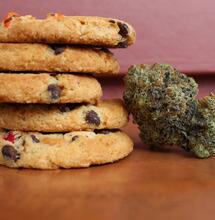The evening tea

Sometimes I feel nostalgic about the time when cannabis was legal everywhere and we could drink our evening tea, made with our favourite ingredient, peacefully. The properties of cannabis tea have indeed been underestimated for rumours about its being ineffective – spread by people who only use weed to get high and do not find the effects of tea similar to the bubbly properties of inhalation.
Clearly, in medical terms too, inhaled cannabis is stronger than tea because cannabinoids are barely soluble in boiling water. However users making their first experience with this herb and those who have health problems and do not want to be in a continuous psychoactive state, could benefit from the advantages offered by tea in many respects.
First and foremost, a cannabis tea can be easily prepared. According to the recipe of Bedrocan B.V., who supply therapeutic cannabis from Holland to various parts of the world, to prepare a good tea you need to boil 500 ml of water in a kettle or covered pan. You then add two teaspoons of cannabis (0.5 g), lower the heat and simmer slowly for 15 minutes, while keeping the pan covered, for the aroma and colour to be fully dissolved in water (as the pigments and terpenes of cannabis are water soluble). The recipe may of course change by using resin powder (hashish) or adding tea leaves or cinnamon.
Filter the prepared tea through a strainer into a cup or thermos for your daily consumption. If you wish to prepare an infusion for more days, just brew 1 gram of herb in 1 litre of water. In this case, Bedrocan recommends adding a teaspoon of coffee cream to the hot drink, so as to keep the substances active and prevent them from sticking to the tea-pot, which would reduce the effect of the drink. Then you should let the tea cool down and, if need be, store it in the fridge for a few days. The tea will then be warmed up as need and, preferably, sweetened with honey, sugar or syrup.
As regards posology, Bedrocan recommends starting with a cup of tea of 0.2 .litres in which 0.2 grams of marijuana will be brewed. The tea will be consumed in the evening, every day, for one to two weeks. If, after this period, the herb still has to cause the desired relief, after consulting a doctor, you can opt for an extra cup with the same dose to be drunk in the morning.
The tea should be sipped slowly, otherwise taste could be very intense, especially if the plant tops were used for its preparation. Effects will appear after 30-90 minutes from drinking, peak 2-3 hours later and last up to 4-8 hours after that peak. The effects of inhaling is different. A tea acts slowly on a part of the stomach, a bit further down from the lungs. It has nothing to do with the immediate effect of a vaporiser and will end after a longer period. For this reason a cannabis tea is preferable for consumers who have chronic problems such as arthritis for instance.
When preparing tea, the herb needs to boil in water at a temperature below the temperature at which the herb is vaporised or burnt in a joint. The decarboxylation, which causes the THCA (or THC in acid form) to become psychoactive by turning it into THC, is less marked than that obtained through inhalation, which results in a milder effect. Therefore, if even two infusions per day are not enough to remedy the sickness, again after consulting a doctor, consumers should try to inhale cannabis with a vaporiser as its dosage may be adjusted more easily in this case.
In the Rastafarian culture (created in 1930), which clashed with the imperialistic culture and, for this very reason, was banned in 1937, cannabis is considered the “herb of life”, i.e. biblically the “leaf of the tree of life that will heal the Nations” (after its worldwide legalisation), while the uninterrupted smoking of ganja is associated with madness, which will only end when users stop inhaling it for a given period. In Jamaica, on the other hand, cannabis tea is considered by everyone a folk remedy and the Rastafarians know that a ganja infusion is a cure-all and a tonic. Women also use it against nausea during pregnancy and also give it to their children, when needed, to cure stomach ache for instance.
Personally I noticed that the Yummy sativa of the Dutch CBD-Crew, with CBD and THC in equal quantities (6-7%), is excellent in an infusion to improve breathing inter alia. Yummy is an exceptional medical herb for its rich cannabinoid content (no psychoactivity). Similarly the Bediol variety produced by Bredroca B.V., is theoretically suited for the treatment of children. If tea is prepared with just the flower of this plant, its taste will be really powerful and spicy, and will make users’ eyes gleam and their senses open. Drinking it, I felt a very pleasant bodily sensation caused by the CBD, with significant benefits for the full body.
Cannabis is not a way of wasting herb, as many people fear. Quite the reverse, it is a gentle and efficient delivery method and is good for the mind, which will feel the benefits of the herb for several hours. It is also worth remembering that, in case of need, given the scarcity typical of prohibition, an infusion can also be made from harvest waste, such as leaves (preferably the smaller ones close to flowers and with resin obviously) or plant top trimmings. The taste and smell will be less pleasant than that of nice flowers and, in general, infusions will be less powerful but invariably please the body.



